
Article provided by: Taito Bunka Marche
A legendary calligrapher who was active in China about 1700 years ago and was later revered as a "sage of calligraphy." Wang Xizhi (303-361, heresy) and his most famous work, " Ranting order The exhibition “Wang Xizhi and Rantei Cho” , which focuses on ” , is being held at the Taito Ward Calligraphy Museum.
* During the period, the exhibition will be changed according to the following schedule.
First term: January 31 (Tue) – March 12 (Sun) Second term: March 14 (Tue) – April 23 (Sun)
* Click here for the list of exhibited works
*This exhibition is a joint project with the Tokyo National Museum.
*The images posted were taken with special permission.
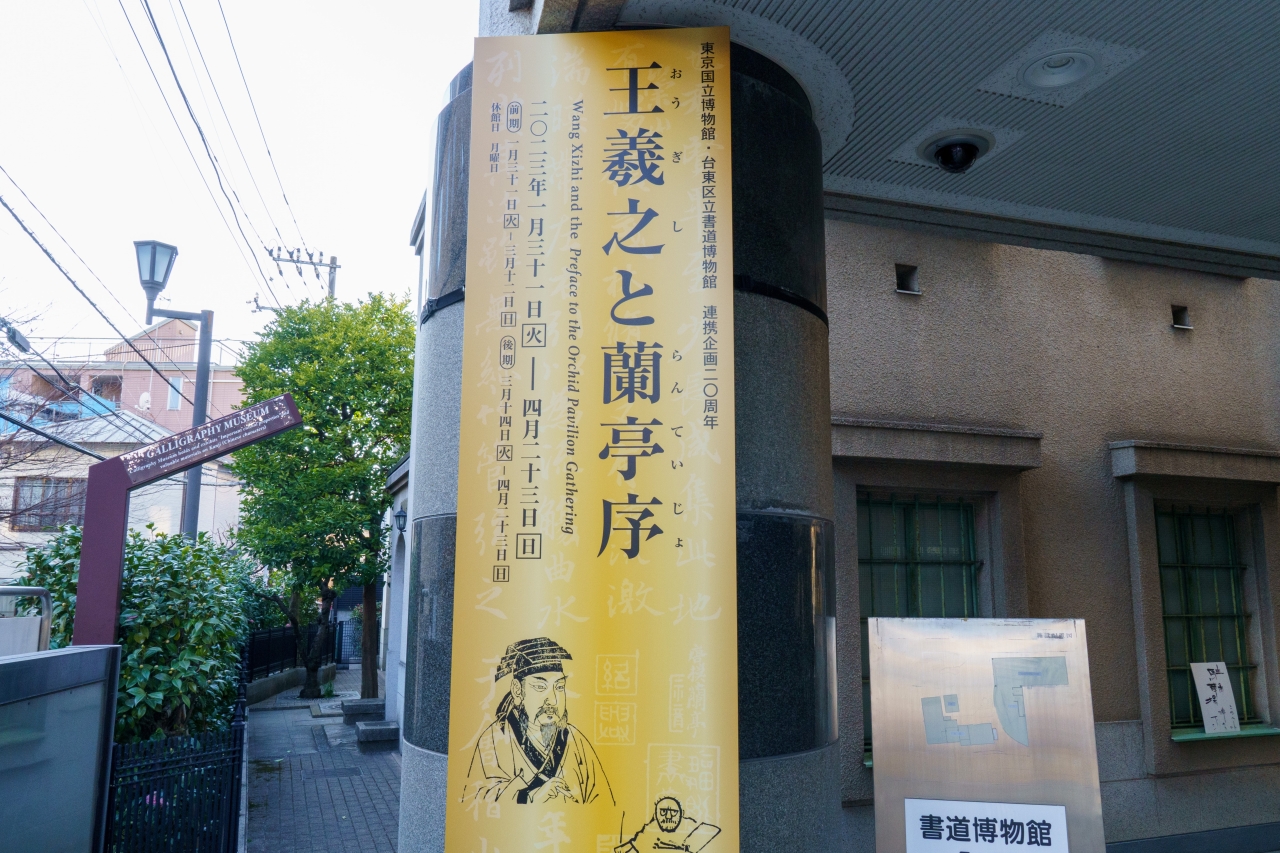
Calligraphy museum entrance

Exhibition view
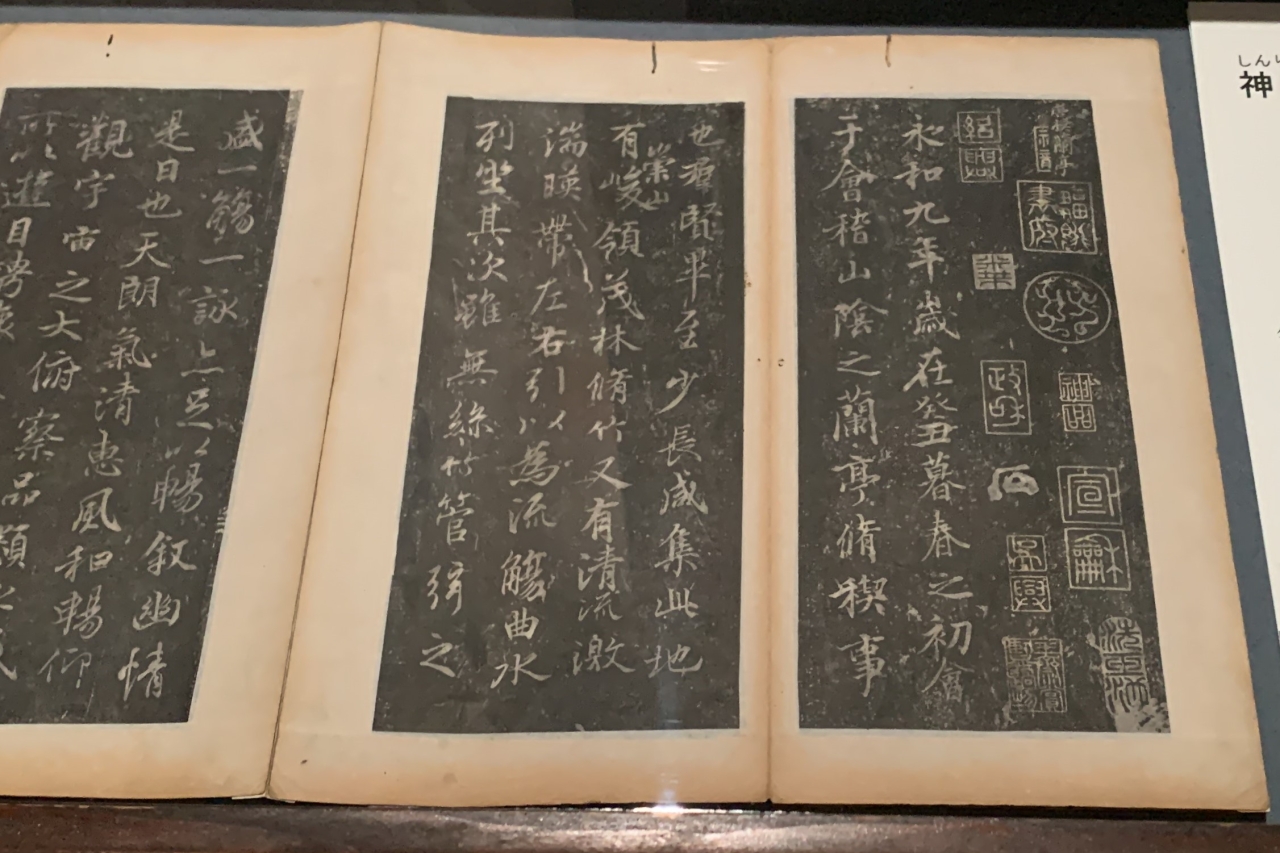
《Shinryu Honran Tei Introduction – Formerly owned by Yamamoto Shuzan》 Wang Xizhi / Original Site: Eastern Jin Dynasty, Yonghe 9th year (353) / Taito Ward Calligraphy Museum / Exhibited in the first half
The most famous calligrapher, but there is no true trace? About Wang Xizhi
In the history of China, calligraphy flourished most during the Eastern Jin Dynasty in the 4th century, when an elegant aristocratic society was formed. Wang Xizhi appeared at a time when the aristocrats, who were striving to achieve the ultimate in elegance in all aspects of their daily lives, began to add artistry and criticality to calligraphy, which had been all about practicality.
Wang Xizhi refined cursive, cursive, and square script, which were transitional calligraphy styles at the time, and made great strides in artistry while incorporating his own emotions into calligraphic expression. The advanced new style of calligraphy with universal beauty that he acquired became the source of calligraphic norms even in Japan, where Wang Xizhi's calligraphy was introduced in the Nara period, and to this day it is synonymous with nosho. It is
"Rantei Chou" (353) is such a representative work of Wang Xizhi, and a masterpiece that shines brilliantly in history. This is a draft of the preface of a collection of poems written in March of the 9th year of Yonghe (353), written at a banquet held by Wang Xizhi inviting 41 celebrities in the scenic land of Lanting in Guiji (Shaoxing City, Zhejiang Province). .
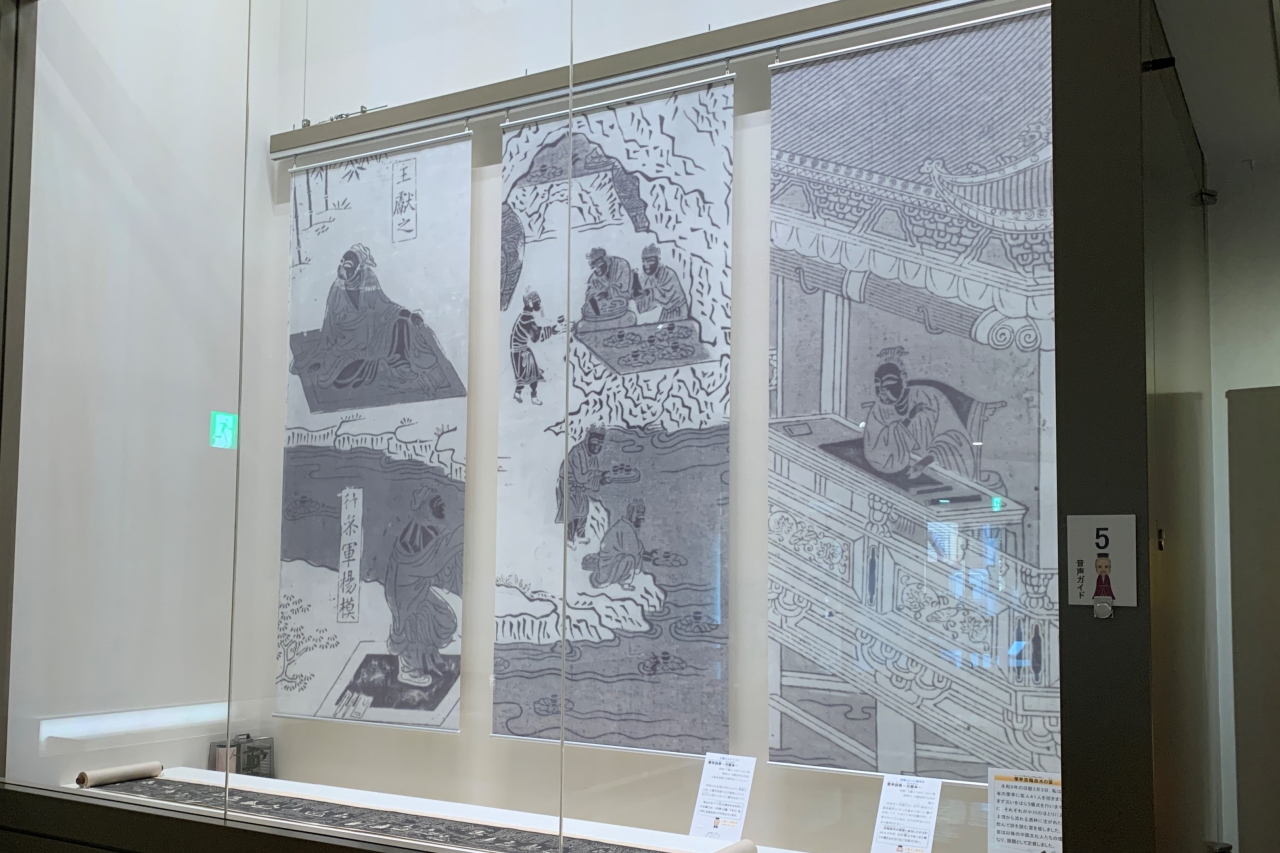
《Rantei Zukan – Manrekibon》Wang Xizhi et al./Ming Dynasty, 1592/Goto Museum of Art (Uno Sesson Collection)/Enlarged photo of the first half of the exhibition. It depicts a banquet at Rantei.
Wang Xizhi improvised while intoxicated with a draft of Ranteijo, written in beautiful cursive script, full of emotional sentiments about the pleasures of parties and the ephemerality of life. Anecdotally, no matter how many times he tried to make a clean copy, it never turned out better than the draft. Even now, it is treated as a compulsory work for people who are trying to learn gyosho.
Wang Xizhi's calligraphy, including "Ranteijo", was highly valued during his lifetime and was the object of collection among the aristocrats, but in fact, it seems that not a single true copy has survived.
In addition to being gradually lost due to wars and natural disasters, 300 years after the death of Wang Xizhi, the Tang dynasty who loved his calligraphy Taejong The main reason is that the emperor (598-649) thoroughly collected them and buried them together with the Ranteijo when he passed away. However, Emperor Taizong commissioned excellent calligraphers to make "copies" such as copies and rubbed copies of works such as "Lanting Cho" and gave them to his subjects, and Wang Xizhi's advanced calligraphy was passed down to future generations. It's decided.
The special exhibition "Wang Xizhi and Rantei Cho" was planned to commemorate the 20th anniversary of the collaborative project between the Tokyo National Museum and the Calligraphy Museum. Paintings and calligraphy that show the influence of these works are exhibited in both museums.
"Ranteijo" appeared one after another. Which is the essence of Wang Xizhi?
The major feature of the exhibition is that you can compare more than 10 types of "Ranteicho" in the first half and the second half.
“Ranteijo” has been duplicated and duplicated. For this reason, the strength, speed, and speed of the characters are all subtly different, and the "Ranteijo" of various histories has been handed down, reflecting the skill of the people involved in the reproduction and the image they had of Wang Xizhi.
In the first half of the exhibition, we were able to appreciate 《Sadatake Honran-tei Chorus》 Hanju ship book ―》《Shinryu Honran Tei Introduction― Yamamoto Kakuzan Former Collection―》《 Yui Honrantei-jo Wenzhi Wang Former Collection―》《 Senwa Naifu Former Zorantei Cho” , etc. By the way, the phrases such as "XX book" in the title of the work are used to distinguish it from other "Ranteijo", such as the land where the stone that was the basis of the rubbing was found and the unique characteristics of the work.

《Jingwu Honran Pavilion – Han Zhu Ship》 Wang Xizhi / Original Site: Eastern Jin Dynasty, Yonghe 9th Year (353) / Taito Ward Calligraphy Museum / Early Exhibition

《Jingwu Honran Pavilion – Han Zhu Ship》 Wang Xizhi / Original Site: Eastern Jin Dynasty, Yonghe 9th Year (353) / Taito Ward Calligraphy Museum / Early Exhibition
《Jingu Honran Teijo – Hanjusenbon》 has a subdued character and an overall cool feel. When Emperor Taizong ordered his retainers to copy the “Rantei Cho'', the one who was the best was counted as one of the “three great masters of the early Tang''. ouyang (557-641). This work is said to be a rubbed copy from the Song Dynasty, which is particularly old among the many “Seibubon'' lineages.
The next thing that caught my eye was "Shinryu Honran Tei Chou – Formerly owned by Yamamoto Kakuzan -" . The "Shinryu book" is named after the fact that the beginning and end of the text are half-stamped with the name of the Tang dynasty era, "Shenryu." The "Shinryu-bon" is characterized by its lively and colorful characters compared to others, and it is often featured in textbooks because it is easy to read and learn.

《Shinryu Honran Tei Introduction – Formerly owned by Yamamoto Shuzan》 Wang Xizhi / Original Site: Eastern Jin Dynasty, Yonghe 9th year (353) / Taito Ward Calligraphy Museum / Exhibited in the first half
However, according to Mr. Nakamura, the museum's chief researcher, the character style of the Shenlong version reflects the refined aesthetics of the Tang dynasty. If so, it should be a little more simple.” Certainly, when I looked at the same work compared to others, I felt that the splashes and harassments were a little exaggerated.
Even in the same system, the character appearance is quite different and it is worth seeing. There seems to be various backgrounds, such as whether the person who duplicated it unconsciously brought out his own color, or whether he changed it intentionally to appeal to the people of the time. This is also a personality that was born because there is no true trace of "Ranteicho" and it is impossible to match the answers.
In addition to "Lanteicho", there are several other works by Wang Xizhi (although they are reproductions) on display at the same exhibition, so even those who are not familiar with calligraphy will wonder, "Which Ranteicho still retains traces of Wang Xizhi?" You can enjoy it while considering it.
Also, although it goes without saying, there is something to be learned from watching Ranteijo on its own. For example, the kanji character '之' appears frequently in 'Ranteijo', and I was surprised to find that each was written in a unique style and style.
I don't know much about calligraphy, so I vaguely imagine that a person who is good at calligraphy has the best character shape perfected in themselves and always outputs that character shape without blurring. was However, in “Ranteijo'', “之'' is written differently depending on the context. When viewing the work while reading the Japanese translation of "Ranteijo" in the exhibition room, one realizes that the charm of this work lies not only in the scenery, but also in the rich power of expression that conveys the artist's emotions. I felt that I could understand part of the greatness of Wang Xizhi, who created the basics of calligraphy art.
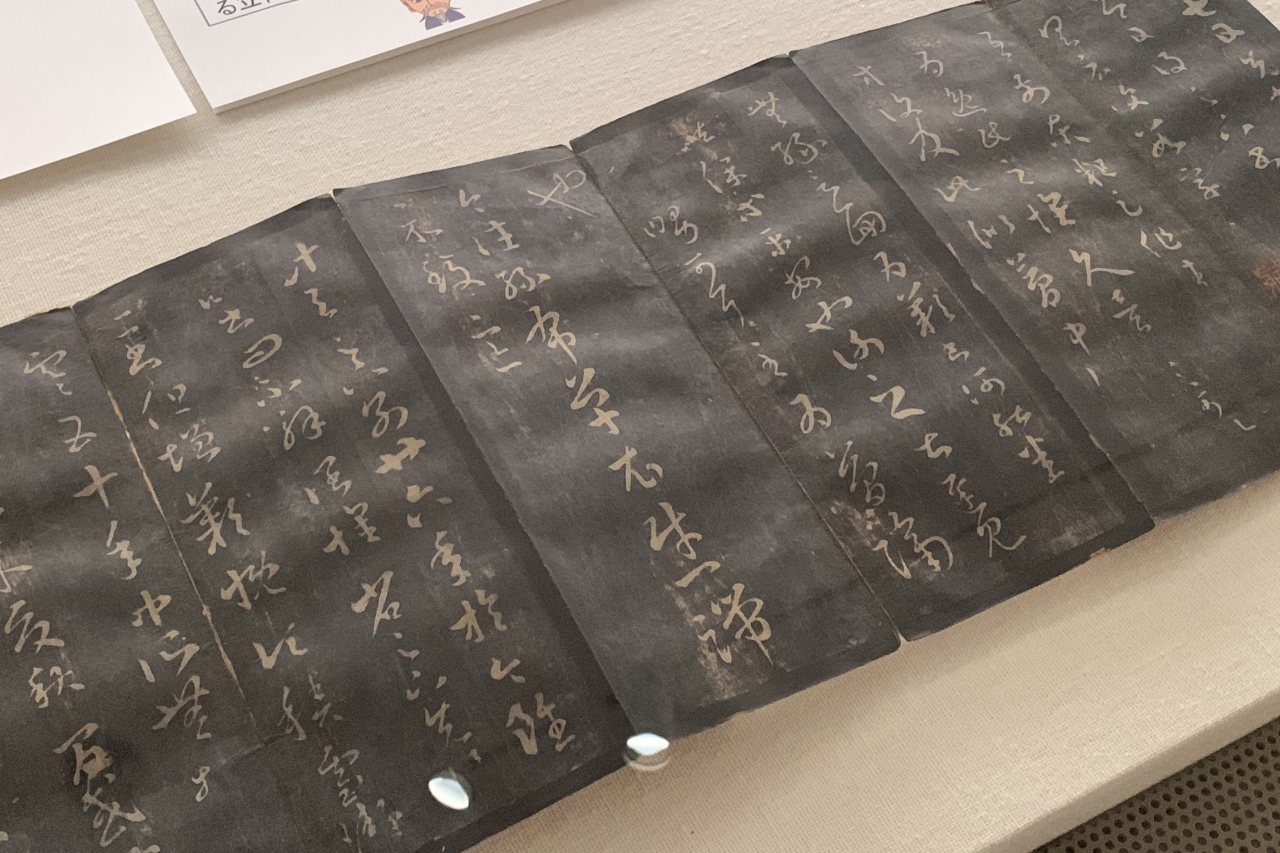
《Seventeen chapters – Missing seventeen lines》 Wang Xizhi / Original site: Eastern Jin period, 4th century / Taito Ward Calligraphy Museum / Exhibited in the first half
In addition to the "Lanting Preface, " several "Seventeen Chapters," a collection of 29 letters written in cursive by Wang Xizhi, are also on display in the first half and second half.
"At first glance, it's a plain work. The content of the writing conveys a feeling of poor health, but the fact that it's written in beautiful characters, even though it's said to be in poor health, gives the impression of Wang Xizhi. It's nice, but the spacing and size between the characters is also a highlight.Just like there are main characters and supporting characters in a drama, there are characters that look good in calligraphy as well, and there are characters that look gorgeous, such as those with harai on the left and right. Please pay attention to the harmony of the entire calligraphy that has been completed.” (Mr. Nakamura)
Creating works with Wang Xizhi font? The popularity of Wang Xizhi is also in Japan…
The exhibition will also display calligraphy from before, during, and after the appearance of Wang Xizhi. In subsequent works, we can see how great the influence of Wang Xizhi was.
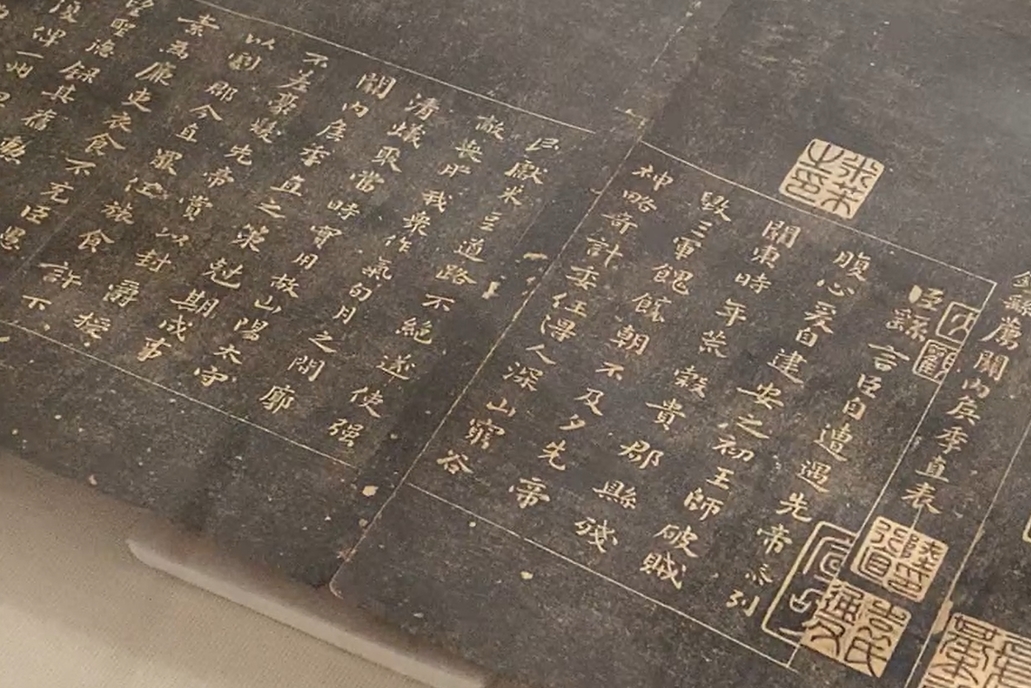
《Recommendation Jikihyo (Shinsho Saijo – Fire Book)》 Zhong Yuan/Original Site: Later Han-Wei Dynasty, 2nd-3rd century/Taito Ward Calligraphy Museum/Exhibited for the entire period
A master of regular calligraphy who was active from the end of the Later Han dynasty to the Wei dynasty of the Three Kingdoms, and was said to be admired by Wang Xizhi. shong ( 151-230 ) recommendation ( Shinsho Saijo -Higobon-)” is “the first step in the development of calligraphy from slave script to regular script over a long period of time,” says Mr. Nakamura. There are remnants of clerical writing, and primitive characters that are slightly short and wide can be seen.
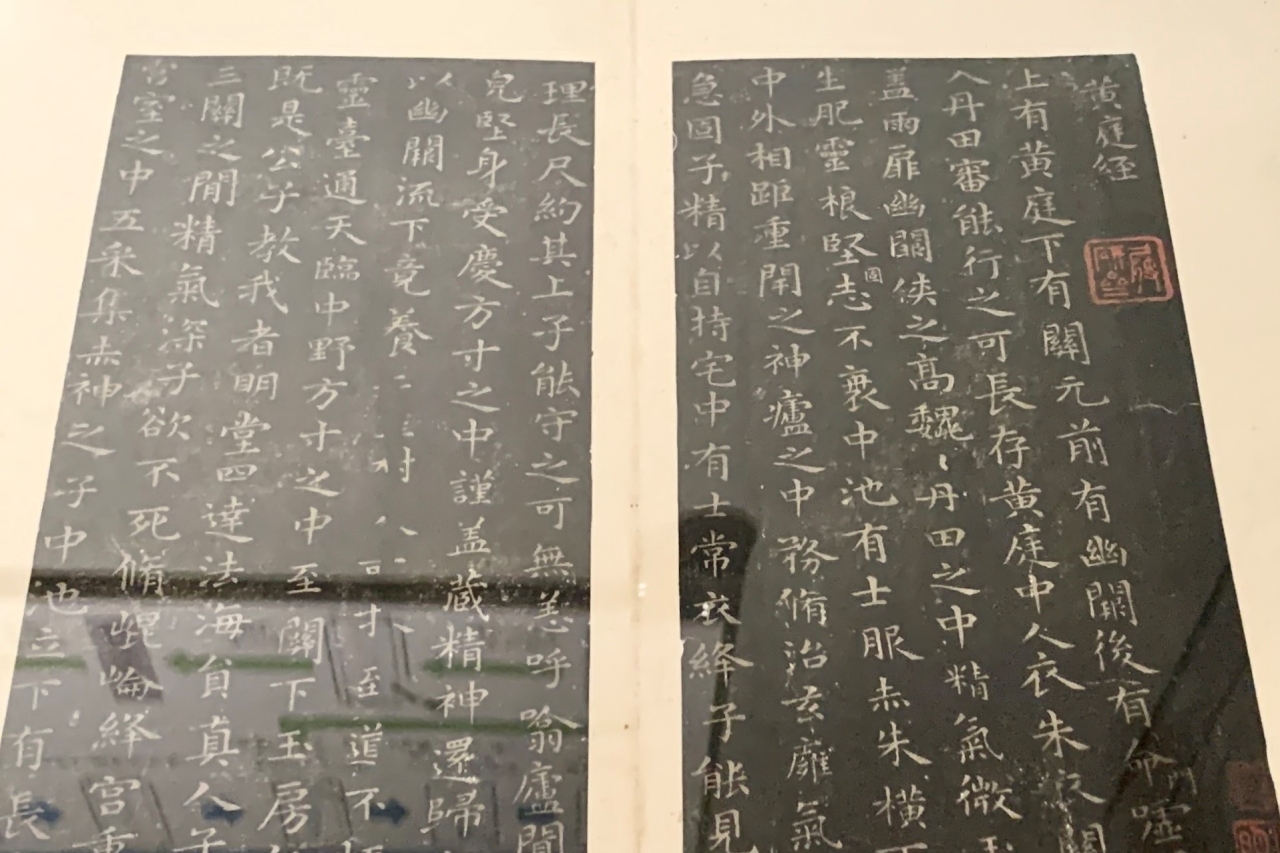
《Yellow Garden Sutra》Wang Xizhi/Original site: Eastern Jin Dynasty, Yonghe 12th year (356)/Taito Ward Calligraphy Museum/Exhibited for the entire period
Wang Xizhi's << yellow court sutra 》 and << Filial Lady Cao'e Monument 》 (Original site: Eastern Jin Dynasty, 2nd year of Xiuping (358) / Displayed for the entire period). Compared to Sho's calligraphy, it was noticeably more sophisticated, and I felt that he had grown taller and had a natural character style and brushwork that closely followed the movement of humans writing letters with a brush. I would like you to actually compare them.
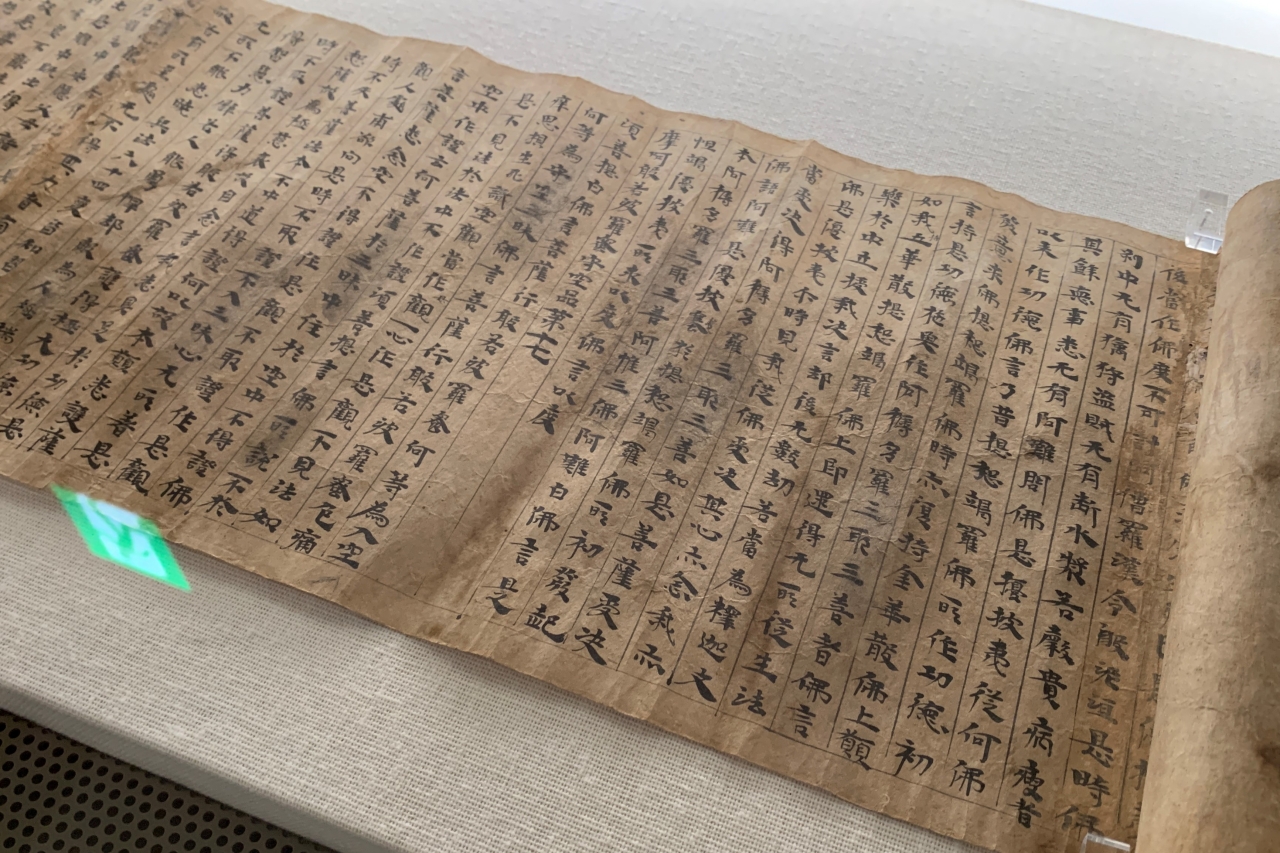
《Dogyo Hannya Sutra Vol. 6 and 7》 Western Jin Dynasty, Yongjia 2nd year (308) / Taito Ward Calligraphy Museum / Exhibited in the first half

《Dogyo Hannya Sutra Vol. 6 and 7》 Western Jin Dynasty, Yongjia 2nd year (308) / Taito Ward Calligraphy Museum / Exhibited in the first half
Wang Xizhi's works of about the same period include Michiyuki Hannya Sutra Vol . Handwriting before the Tang dynasty is very valuable. You can see the true appearance of the calligraphy in the era when Wang Xizhi lived.

《Shinji Temple Inscription》Tang Taizong/Tang Dynasty, 20th year of Jogan (646)/Taito Ward Calligraphy Museum/Exhibited in the first half
The running calligraphy of Emperor Taizong of Tang, the central figure in the myth of Wang Xizhi Jin Temple inscription 》 was also there. It's comfortable to write with a solid and dignified style like an emperor.
“A layman tends to think that if you write in cursive or cursive script by connecting lines to create a sense of speed, the calligraphy of Emperor Taizong was cut off on purpose. If you add too much leeway, the characters will look sloppy, but for the character "Moon", for example, the lines facing each other between the first and second strokes are tightened. I hope you will enjoy that sense of balance." (Mr. Nakamura)
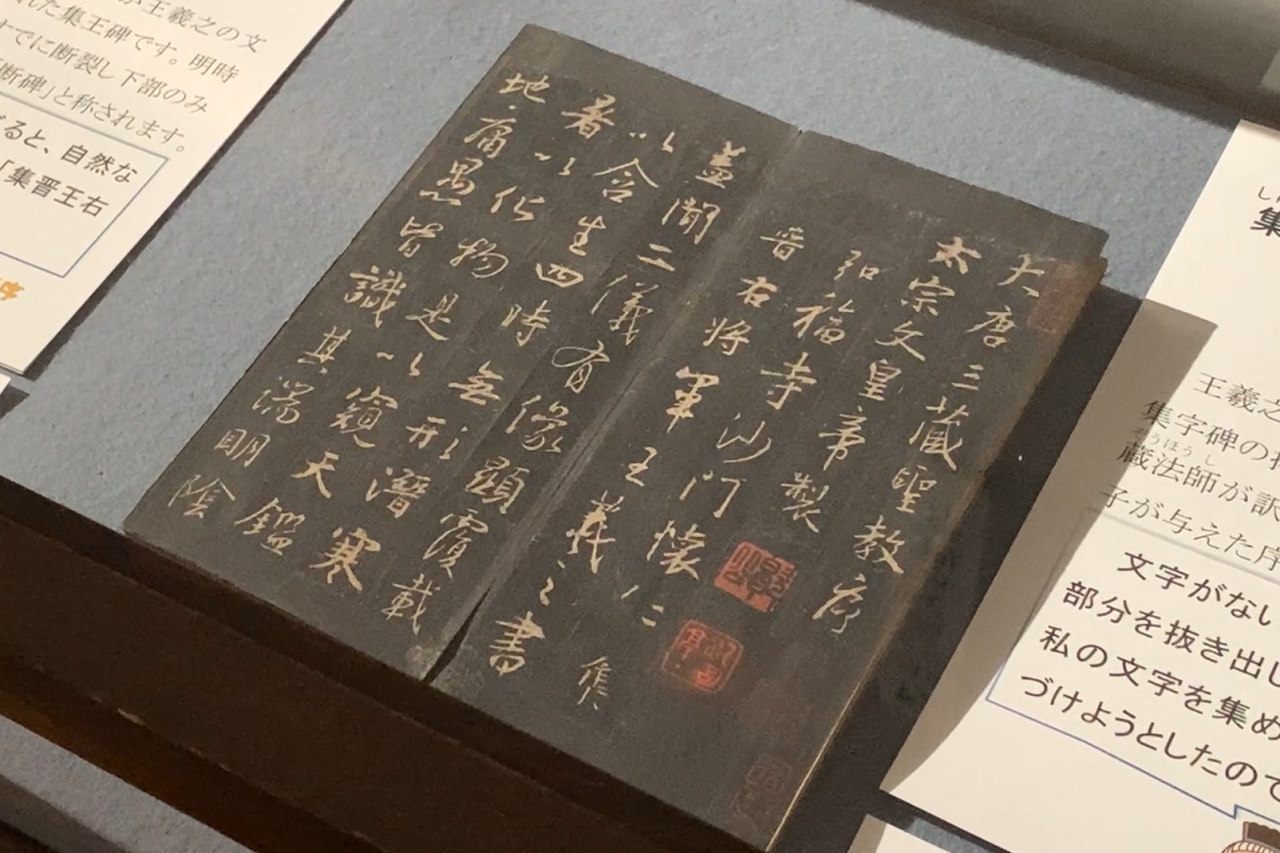
《Sacred Teachings of the King》 Wang Xizhi / Tang Dynasty, Xianheng 3rd year (672) / Taito Ward Calligraphy Museum / First half exhibition
As an indication of the popularity of Wang Xizhi after the Tang Dynasty, Holy Order of Kings ” and “Kofuku-ji Temple Cut Monument” (Wang Xizhi / Tang Dynasty, Kaiyuan 9 (721)) are interesting. It is said that it is a rubbed copy made from a stone monument in which each character is collected from Wang Xizhi's calligraphy and made into sentences as if it were written by Wang Xizhi. The thickness of the lines in "Shu-o Sei Kyojo" has a collage-like atmosphere, but "Kofuku-ji Temple" is quite skillfully harmonized as a whole.

《Junkakakucho-Kyosetsubon》Edited by Wang/Northern Song Dynasty, 3rd year of Junka (992)/Taito Ward Calligraphy Museum/Exhibited in the first half
A complete collection of popular Chinese calligraphy created in the Song dynasty . Junkakakucho ― heavy snow The book—” also contained Wang Xizhi’s calligraphy as a matter of course. According to the story, out of the 10 volumes, Wang Xizhi is introduced in volumes 6-8, and his son Wang Xianzhi is introduced in volumes 9-10. understand. When I came this far, I laughed at the size of the influence.
At the end of the exhibition, we introduced how Wang Xizhi was received in Japan. In the Heian period, Kukai and Ono Dofu, who learned from the copies of Wang Xizhi brought back by the envoys to Tang Dynasty, rose to prominence, and after their success, Japanese-style calligraphy called Kokufu Bunka and Wayo was established. In the Edo period, the trend toward respect for Wang Xizhi became stronger due to the popularity of Tang-style calligraphy, and at the end of the Edo period, a large number of Wang Xizhi calligraphy pamphlets (rubbed copies arranged in the form of calligraphy) began to reach Japan. It seems that it has always had an overwhelming presence not only in China but also in the history of Japanese calligraphy.

"Rantei Preface" Gochiku Nakabayashi / 1892 / Taito Ward Calligraphy Museum / Exhibited for the entire period
Among Japanese works, Rantei Preface by Gochiku Nakabayashi (1827-1913), a great master in the Meiji period, caught my eye. It is a work that I finished the sentences of "Ranteijo" in my own style, and the richness of the variation of the character line is not something you see very often.
Until now, when I looked at the calligraphy of Wang Xizhi, I couldn't understand what I should pay attention to, saying, "It's certainly beautiful, but it's kind of ordinary." However, when I visited the exhibition, I felt that the feeling of being "normal" itself may be proof that people continue to be Wang Xizhi's followers even after 1700 years. became.

A newspaper illustration of "Ranteijo" drawn by Fusetsu Nakamura, the founder of the Calligraphy Museum. 《Calligraphy King Xyuki Rantei Kiwo Written (Zodiac Chapter)》 Taisho 1st year (1912) / Taito Ward Calligraphy Museum / Exhibited for the entire period
For a limited time only, the exhibition will feature three works related to the "Seisetsu New Book," a collection of gossip from the time Wang Xizhi lived, written during the Tang Dynasty, when the most beautiful regular script in China was written. Appears in All of them are national treasures written by hand.
From January 31 to March 12 , Sesetsu Shinsho Vol.
From February 28th to March 26th , 《Seisetsu Shinsho Vol.
From March 28 to April 23 , Sesetsu Shinsho Vol.
Don't miss this rare opportunity.
The Tokyo National Museum, which has joint exhibitions, is within walking distance, so please visit both museums.
Overview of the special exhibition “Wang Xizhi and Ranteijo”
| exhibition period | January 31 (Tue) – April 23 (Sun), 2023 * During the period, the exhibition will be changed according to the following schedule. First term: January 31 (Tue) – March 12 (Sun) Second term: March 14 (Tue) – April 23 (Sun) |
| venue | Taito Ward Calligraphy Museum |
| Opening hours | 9:30 a.m. to 4:30 p.m. (Admission until 4:00 p.m.) |
| closing day | Mondays (or the following weekday if it falls on a public holiday), special organizing periods, etc. |
| Admission fee | General 500 yen Elementary, junior high and high school students 250 yen
*Admission is free for those with a disability certificate, rehabilitation certificate, mental disability certificate, or specific disease medical care recipient certificate and their caregivers. |
| Taito Ward Calligraphy Museum Official Site | https://www.taitocity.net/zaidan/shodou/ |
| List of exhibited works | https://www.taitocity.net/zaidan/shodou/wp-content/uploads/sites/7/2023/02/kikakuten_20230131.pdf |
*The content of the article is as of the date of the interview (February 9, 2023). Some works may have already been exhibited, so please check the official website and the list of exhibited works for details.
<Past coverage report>
[Interview report] Shogun's warriors who landed in Japan for the first time! "Terracotta Warriors and Ancient China Exhibition" Opens at Ueno Royal Museum
